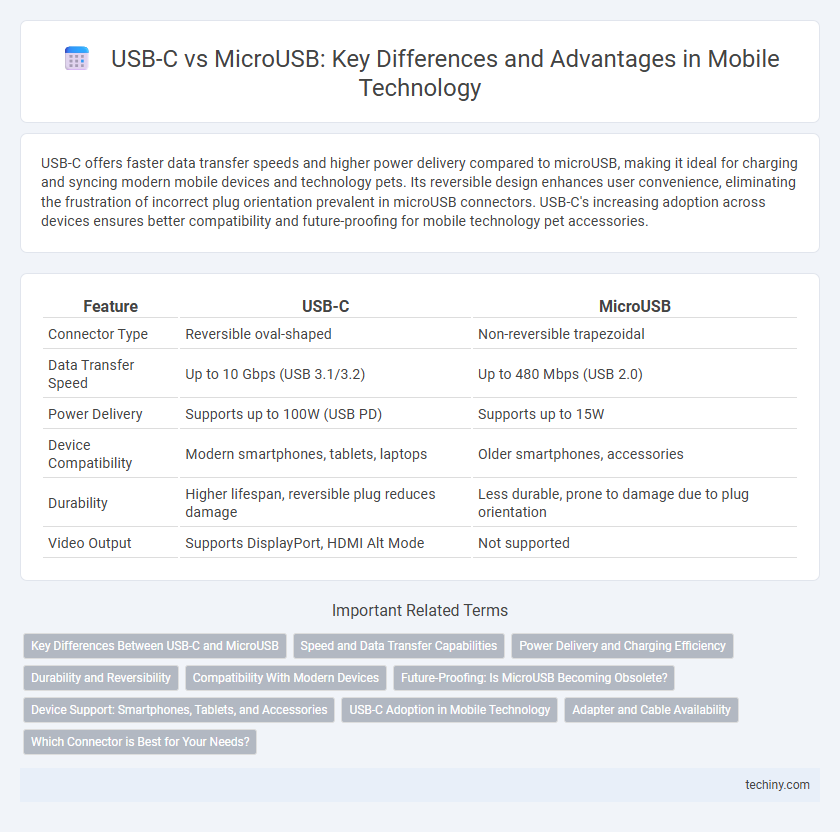USB-C offers faster data transfer speeds and higher power delivery compared to microUSB, making it ideal for charging and syncing modern mobile devices and technology pets. Its reversible design enhances user convenience, eliminating the frustration of incorrect plug orientation prevalent in microUSB connectors. USB-C's increasing adoption across devices ensures better compatibility and future-proofing for mobile technology pet accessories.
Table of Comparison
| Feature | USB-C | MicroUSB |
|---|---|---|
| Connector Type | Reversible oval-shaped | Non-reversible trapezoidal |
| Data Transfer Speed | Up to 10 Gbps (USB 3.1/3.2) | Up to 480 Mbps (USB 2.0) |
| Power Delivery | Supports up to 100W (USB PD) | Supports up to 15W |
| Device Compatibility | Modern smartphones, tablets, laptops | Older smartphones, accessories |
| Durability | Higher lifespan, reversible plug reduces damage | Less durable, prone to damage due to plug orientation |
| Video Output | Supports DisplayPort, HDMI Alt Mode | Not supported |
Key Differences Between USB-C and MicroUSB
USB-C offers reversible plug orientation and faster data transfer rates up to 10 Gbps compared to MicroUSB's limited 480 Mbps. USB-C supports higher power delivery up to 100 watts, enabling rapid device charging and compatibility with larger devices, unlike MicroUSB's lower power capacity of around 15 watts. The universal design of USB-C enhances durability and streamlines connectivity across smartphones, tablets, and laptops, while MicroUSB remains common in older or budget devices with limited functionality.
Speed and Data Transfer Capabilities
USB-C supports significantly faster data transfer speeds, with USB 3.1 and USB 3.2 standards reaching up to 10-20 Gbps, compared to microUSB's maximum of 480 Mbps under USB 2.0. The reversible design of USB-C enhances user convenience, allowing for quicker and more efficient connections during data transfer. USB-C also supports advanced protocols, enabling simultaneous power delivery and high-speed video output, which microUSB cannot achieve.
Power Delivery and Charging Efficiency
USB-C offers significantly higher Power Delivery capabilities compared to microUSB, supporting up to 100W of power, which enables faster charging for a wide range of devices including smartphones, tablets, and laptops. The reversible design of USB-C connectors enhances durability and ease of use, while microUSB typically supports lower power levels, limiting its charging speed and efficiency. Enhanced data transfer rates and improved power negotiation in USB-C contribute to overall better charging efficiency and device performance.
Durability and Reversibility
USB-C connectors offer superior durability with a robust design rated for over 10,000 insertion cycles compared to microUSB's lower endurance of approximately 1,500 cycles. The reversible plug orientation of USB-C eliminates the frustration and potential damage caused by incorrect cable insertion, unlike microUSB ports that require precise alignment. This combination of enhanced longevity and ease of use makes USB-C the preferred standard for modern mobile technology.
Compatibility With Modern Devices
USB-C offers superior compatibility with modern devices compared to microUSB, supporting fast data transfer and charging in smartphones, tablets, and laptops. Its reversible connector design eliminates the frustration of incorrect port orientation, enhancing user convenience across various gadgets. MicroUSB remains common in older devices but lacks the widespread adoption and advanced features of USB-C in current technology ecosystems.
Future-Proofing: Is MicroUSB Becoming Obsolete?
USB-C is rapidly becoming the industry standard for mobile devices due to its reversible design, faster data transfer rates, and higher power delivery compared to microUSB. Many manufacturers are phasing out microUSB ports in favor of USB-C to ensure compatibility with future technologies and support faster charging protocols. As a result, microUSB is increasingly viewed as obsolete, limiting its use to older devices and making USB-C essential for future-proofing mobile technology.
Device Support: Smartphones, Tablets, and Accessories
USB-C offers broader device support compared to microUSB, as it is now the standard for most modern smartphones, tablets, and accessories, including flagship models from brands like Samsung, Google, and Apple's iPad Pro. MicroUSB remains prevalent in budget smartphones and older devices but lacks compatibility with newer high-speed data transfer and power delivery protocols found in USB-C. Accessories such as wireless headphones, chargers, and external storage have largely transitioned to USB-C, ensuring faster charging and improved connectivity across a wide range of mobile technology products.
USB-C Adoption in Mobile Technology
USB-C has become the dominant charging and data transfer standard in mobile technology due to its reversible connector design and faster data transfer speeds up to 10 Gbps, outperforming the older microUSB standard. Major smartphone manufacturers, including Samsung, Apple, and Google, have widely adopted USB-C for its compatibility with a broad range of devices and support for higher power delivery, enabling faster charging. The global shift towards USB-C is further driven by regulatory mandates, such as the European Union's requirement for a common charging port to reduce electronic waste.
Adapter and Cable Availability
USB-C adapters and cables dominate the mobile technology market due to their faster data transfer speeds and universal compatibility, offering a wide range of options across numerous brands and devices. MicroUSB cables and adapters, while still available, are increasingly limited and primarily found with older or budget devices, making them less convenient for users seeking versatile connectivity. The growing preference for USB-C ensures better availability of high-quality adapters and cables, improving overall user experience and device interoperability.
Which Connector is Best for Your Needs?
USB-C offers faster data transfer speeds up to 10 Gbps and supports higher power delivery for quick charging compared to microUSB's slower 480 Mbps transfer and limited power capacity. Its reversible design enhances user convenience, reducing wear and compatibility issues common with microUSB's one-way plug. For the latest smartphones, tablets, and laptops, USB-C is the optimal choice due to widespread adoption and future-proofing advantages.
USB-C vs microUSB Infographic

 techiny.com
techiny.com